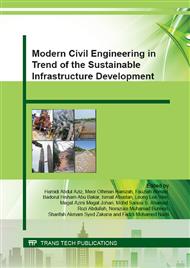[1]
E. Villatrreal, A. Semadeni-Devies and L. Bengtsson, Inner city stormwater control using a combination of best management practices, Ecol. Eng. (2004) 279-98.
DOI: 10.1016/j.ecoleng.2004.06.007
Google Scholar
[2]
A. S. Vieira, C. D. Beal, E. Ghisi and R. A. Stewart, Energy intensity of rainwater harvesting systems : A review, Renew. Sust. Energ. Rev. (2014) 225-242.
DOI: 10.1016/j.rser.2014.03.012
Google Scholar
[3]
M. A. Imteaz, A. Shanableh, A. Rahman and A. Ahsan, Optimization of rainwater tank design from large roofs: A case study in Melbourne, Australia, Resour. Conserv. Recy. (2011) 1022-1029.
DOI: 10.1016/j.resconrec.2011.05.013
Google Scholar
[4]
H. Hashim, A. Hudzori, Z. Yusop and W. Ho, Simulation based programming for optimization of large-scale rainwater harvesting system: Malaysia case study, Resour. Conserv. Recy. (2013) 1-9.
DOI: 10.1016/j.resconrec.2013.05.001
Google Scholar
[5]
C. Matos, C. Santos, S. Pereira, I. Bentes and M. Imteaz, Rainwater storage tank sizing: Case study of a commercial building, Int. J. Sust. Built Env. (2013) 109-118.
DOI: 10.1016/j.ijsbe.2014.04.004
Google Scholar
[6]
R. Farreny, T. Morales-Pinzon, A. Guisasola, C. Taya, J. Rieradevall and X. Gabarrell, Roof selection for rainwater harvesting: Quantity and quality assessments in Spain, Water Res. (2011) 3245-3254.
DOI: 10.1016/j.watres.2011.03.036
Google Scholar
[7]
Aquacraft Inc., Embedded Energy in Water Studies, Study 3 : End-use Water Demand Profiles, Aquacraft Inc., (2011).
Google Scholar
[8]
Chartered Institute of Building Services Engineers, CIBSE Knowledge Series : Reclaimed water, CIBSE, London, (2008).
Google Scholar
[9]
Chartered Institute of Building Services Engineers, Guide G : Public Health Engineering, CIBSE, London, (2004).
Google Scholar
[10]
A. Plappally and J. Lienhard V, Energy requirements for water production, treatment, end use, reclamation, and disposal, Renew. Sust. Energ. Rev. (2012) 4818–4848.
DOI: 10.1016/j.rser.2012.05.022
Google Scholar
[11]
S. Ward, D. Butler and F. A. Memon, Benchmarking energy consumption and CO2 emissions from rainwater harvesting systems : an improved method by proxy, Water Env. J. (2011) 184-190.
DOI: 10.1111/j.1747-6593.2011.00279.x
Google Scholar
[12]
J. Y. Lee, G. Bak and M. Han, Quality of roof harvested rainwater: Comparison of different roofing materials, Env. Poll. (2012) 422-429.
DOI: 10.1016/j.envpol.2011.12.005
Google Scholar
[13]
V. Singh, Elementary Hydrology, Prentice Hall, New Jersey, (1992).
Google Scholar


